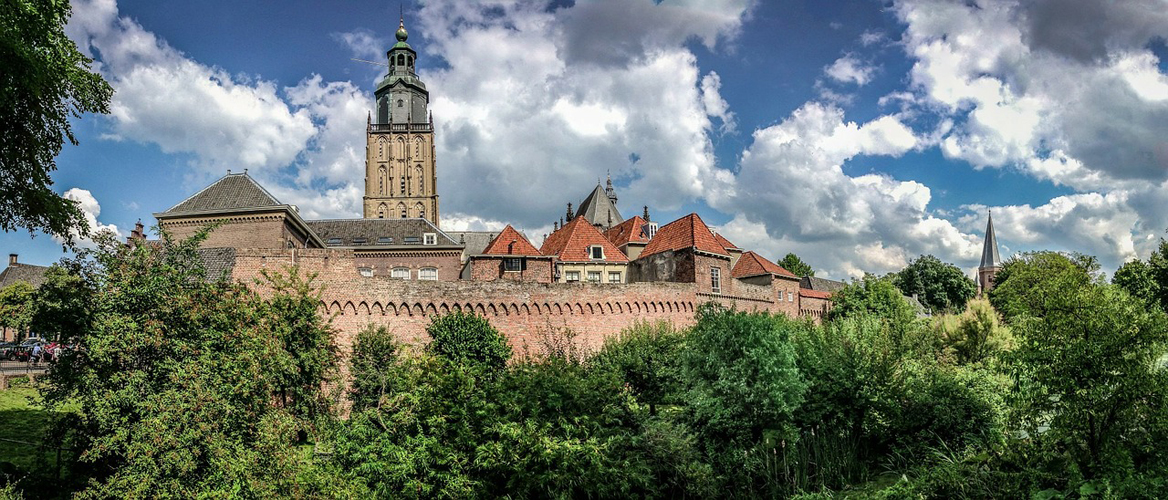Zutphen (population 46,000) is an historic city in the center-eastern part of the Netherlands.
The city has existed since Roman times and received its city rights in 1190, making it one of the oldest medieval cities in the Netherlands. The city was voted as having the best city center of The Netherlands in the category of small cities in 2006. (The winner in the category of major cities was Groningen.) It has an untouched historic city center that gives you the feeling of travelling hundreds of years back in time. It is not widely known to foreign tourists and waiting to be discovered.
Understand : Zutphen is located in a river valley at the river IJssel, a sidebranch from the branch of the Rhine known as the Nederrijn. The small river Berkel (no shipping possible) as well as the major Twentekanaal (channel) flow into the IJssel near Zutphen. The city lies at the border of the hilly forested Veluwe region and the more flat and agricultural Achterhoek. The language spoken is Dutch , nearly everyone speaks English, and German is widely understood.
The settlement received town rights between 1191 and 1196, making it one of the oldest towns in the country. This allowed it to self govern and have a judicial court. Only Utrecht, and Deventer preceded it in receiving town rights. Zutphen, in turn, became the mother town of several other towns in Guelders, such as Arnhem, Doetinchem, Doesburg, Lochem, Harderwijk, Venlo and Emmerich. It also became part of the Hanseatic League, a group of towns with great wealth , this league was the economic centre in that part of Europe.
Access : Coordinates: 52.133333, 6.2 / By public transit : The Zutphen train station isn’t located far from the city centre. Train services here consist of an Intercity between Roosendaal and Zwolle via Nijmegen and Tilburg, and regular trains connecting to Wijchen, Apeldoorn, Winterswijk and Oldenzaal via Hengelo. The train station is well-serviced and is a small hub for the area.
As for buses, the same train station is also the major bus hub, making switching between the two rather easy. Connections from here consist of Line 80 connecting to Vorden, Line 81 connecting to Deventer (though the train to Zwolle is the quicker option for getting to Deventer), Lines 82 and 682, which connect to several towns in Bronckhorst and ends in Doetinchem and Line 273, which is a substitute of the train link to Oldenzaal.
From Amsterdam. In the morning : Take the Intercity from Amsterdam Central to direction Nijmegen till Arnhem, the you have to change train. In Arnhem you take the Intercity in the direction Zwolle. In the afternoon and evening: Take the Intercity from Amsterdam Central to Amersfoort, there you have to chance train to the direction of Enschede. At the first station (Apeldoorn), you change train again: the local train to Zutphen.
During peakhours (morning and afternoon) “Peakhours Intercities” Amsterdam Central – Apeldoorn (direction Deventer) are in service. You don’t need to travel via Arnhem or don’t have to change train in Amersfoort. You only have to take the peakhour Intercity from Amsterdam Central in direction Deventer till Apeldoorn en there change train to the local train to Zutphen.
By car : From Amsterdam : From Amsterdam, follow the A1 highway for about 100 kilometers until Apeldoorn. Just after Apeldoorn, take the exit towards Voorst / Zutphen and follow main road N314 for about 18 kilometers until you reach Zutphen. Note that after about 10 kilometers you reach a round-a-bout where you have to turn right (and follow the N314), and when you enter Zutphen, you will first enter the small part of the city (de Hoven) that lies on the west bank of the river. The road ends at a major junction where you can only turn right or left; turn left onto the IJssel bridge to cross the river and reach the main part of the city
Highlights :
- Its Dutch tourist promotion slogan, “Torenstad”, means “Tower-city”, which refers to the large number of towers. The largest is the Walburgkerk (officially it’s called “St. Walburgiskerk”, but the locals say “Walburgkerk”), located at the square where the city originated. Guided tours are available, organized by the VVV located directly opposite the railway station. These tours will also allow you to visit the medieval library “Librije” – books have been kept here secure since the 1600s by chaining them to the desks.
- ‘s Gravenhof, Kerkhof 3. Containing both the Walburgiskerk, locally known as ‘Walburgkerk’, one of the biggest churches in the country, as well as the old city hall, the ‘s Gravenhof is the place where the city was founded and grew around, filled with both modern and classical buildings.
- City museum, ‘s Gravenhof 4,
- Berkelpoort, Isendoornstraat 21. The Berkelpoort is one of the old gates of the city, spanning the Berkel river.
- Broederenkerk. Fourteenth-century monasterium on the outskirts of the old walled city.
Activities : Visit the weekly markets. A large market is held on Thursday morning, breaking up at around 13:00 (1 PM); a smaller market is held on Saturday throughout the day. The Thursday morning market is one of the biggest in the country.
Hire a bike (railway station), head out over the old bridge, turn right, and pushbike along the most beautiful riverdike, an oasis of quiet and nature. A gem mainly the locals know and really worth it.
Go next :

